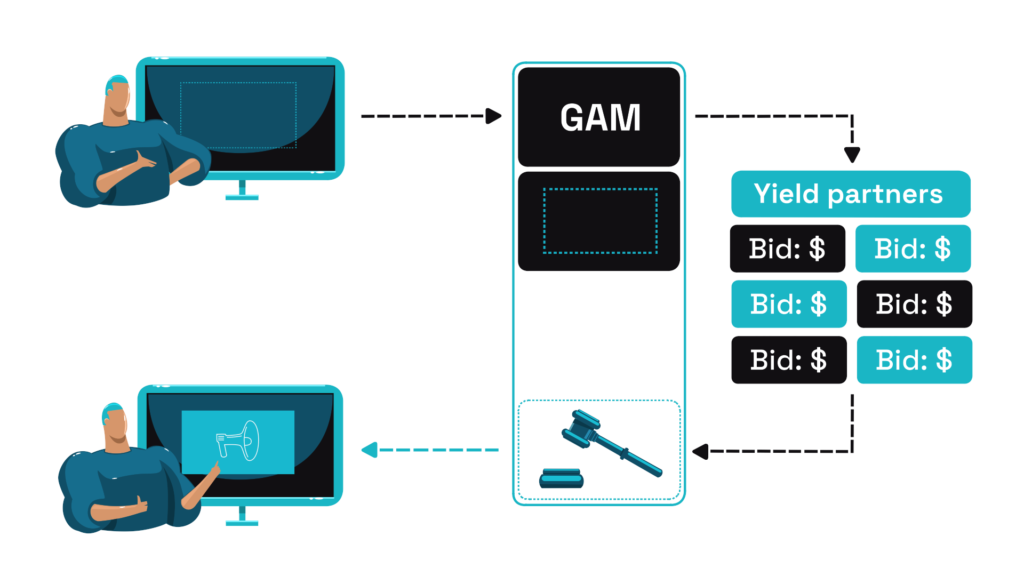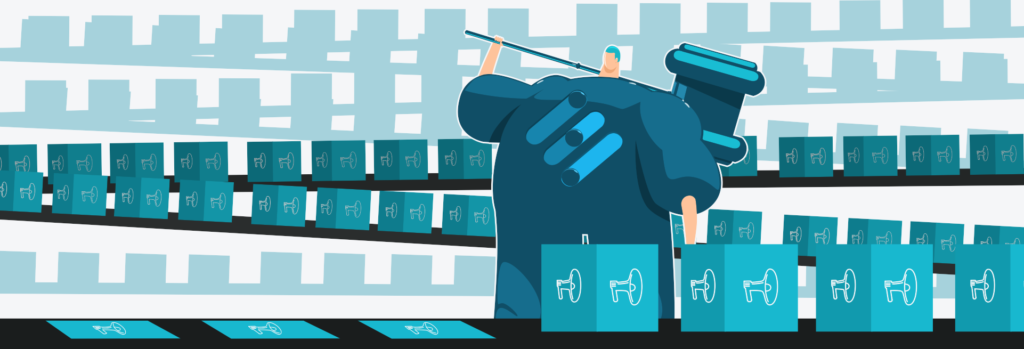A Guide to Google Open Bidding
Google Open Bidding, previously known as EBDA, was introduced to publishers in 2018. It’s a server-side alternative to header bidding.
Open Bidding allows publishers to invite demand partners to a unified, server-to-server auction so that they can bid for impressions on their sites. The auction occurs in the ad server, not the user’s browser.
This article explains what Google Open Bidding is, how it works, and how to implement it to reap the most benefits!
What is Google Open Bidding?
Open Bidding is a server-side unified auction that lets many SSPs and ad exchanges compete against Google’s ad exchange (AdX) for impressions.
In other words, Open Bidding is Google’s server-to-server technology that allows publishers to invite multiple third-party ad exchanges in an auction for their ad inventory.
The server-side unified auction happens in the ad server instead of the user’s browser. This improves the page loading speed, which is important for user experience and Google’s Core Web Vitals scores.
As publishers can choose from multiple yield partners who will bid for their inventory, a higher ad fill rate and eCPM can be seen in the result.
With Open Bidding, demand partners compete in real-time bidding on a first-price basis against Google Ad Manager (GAM) line items (an advertiser’s “order” that includes information about ad unit size, placement, targeting criteria, etc.) in dynamic allocation.
Dynamic allocation is an automatic process that allows all non-guaranteed demand (e.g., open auction, remnant line items) to compete in real-time with guaranteed line items.
What is EBDA?
Google Exchange Bidding Dynamic Allocation (EBDA) is Google’s server-side alternative to header bidding. It’s another word for Open Bidding.
With the help of EDBA, exchanges, and SSPs can compete with Google AdX for impressions.
Yield partners in Google Open Bidding
The primary yield partners in Google Open Bidding are the ad networks and ad exchanges that have agreements with Google to participate as open bidders.
Publishers must have a written contract before allowing a yield partner to bid on their inventory.
Google does not facilitate this arrangement between publishers and open bidders. It only provides a platform for publishers to host auctions on GAM.
How to determine the best yield?
Google Ad Manager runs the unified auctions to ensure publishers receive the maximum yield. Most of the unified auction comprises the yield partners’ and ad exchange bids.
Dynamic allocation is used to insert additional direct line items.
GAM chooses the best line items to maximize the publisher’s revenue.
GAM does this in 4 steps:
- Highest-paying line items are picked for competing in the unified auctions.
- Then, the most relevant line item is selected to compete in the unified auction.
- GAM sends the bid request to targeted yield partners, which then participate in the auction, where the highest bidder gets the ad space.
- GAM selects the winning bid (ad creative), and the server sends it to the publisher when the dynamic allocation and unified auction are complete.
Open Bidding payment type
Google manages all payments based on the volume of impressions each Open Bidding yield partner delivers. Within 30 days of the end of the month, payments are sent to the publisher and demanded from the buyer.
Publishers are paid in line with the agreement of their Open Bidding contract addendum (used to clarify and add things that were not initially part of the original contract) and ad exchange agreement.
Open Bidding impression payments are made after deducting Google’s revenue share. The publisher’s earnings include the revenue from Google ad exchange and third-party demand partners.
How Does Open Bidding Work?
Ad Manager handles all Open Bidding requests through S2S integration between publishers and their demand partners. To start using Open Bidding, publishers must have a Google Ad Manager account with enabled Google AdX.
When the ad request is generated, the Ad Manager runs a unified auction and determines the best yield.
Here are the 4 steps that describe the Open Bidding process:
- Once the user visits your website, an ad request is triggered. The information (e.g., user, device, targeting) is passed to the Ad Manager ad server through Google Publisher Tag.
- The Ad Manager selects the best eligible line items. The server uses yield groups and sends bids to demand partners in each group to collect the highest bid from them.
- Once the Ad Manager receives all bids, it runs a unified auction and compares them between all demand partners.
- After the auction, the winning creative (highest bid) is returned to the publisher and served to the user.

Google Open Bidding – Pros and Cons
Here are 5 advantages of Google Open Bidding:
- Minimized latency. Header bidding requires both the GAM script and the header auction script, whereas Open Bidding only needs the GAM script. Even before the auction begins, faster page load and improved UX result from less JavaScript being used at runtime.
- Reduced complexity. GAM controls the Open Bidding. Therefore publishers don’t need to install or maintain anything extra on their sites.
- Fast unified payments. Google handles billing for Open Bidding. It combines the funds from demand partners and pays publishers according to its Net-30 payment schedule.
- Greater demand. You can add as many demand partners as you want without sacrificing the speed.
- Improved reporting and analytics. Ad Manager provides improved reporting, which helps publishers to identify revenue opportunities in sales channels.
Here are 4 disadvantages of Google Open Bidding:
- Lower cookie match rate. Open Bidding is a server-side solution that lacks cookie matching. Therefore, it has no access to all the cookie data you can get with client-side header bidding because the user’s browser doesn’t send the ad request. It can result in low-performing and irrelevant ads being displayed on the website.
- Complicated entry. To use Open Bidding, a publisher must have an ad exchange account linked to GAM. They also need to sign an Open Bidding addendum to their contract.
- Transparency. Open Bidding isn’t considered that transparent as it doesn’t show the unified auction process. Google controls billing, reporting, optimization, and inventory. Therefore, publishers have less control over the auction process.
- Limited access to bid data. While Google provides advanced analytics and reporting, publishers don’t know anything about the individual bids made by demand partners for every auction.
How to Set Up Google Open Bidding?
Open Bidding in GAM is simple to set up, but a publisher must tick a few boxes before using the bidding feature.
To use Google ad exchange, you must enter into new agreements with other ad exchanges and obtain Google-enabled licenses.
If you don’t already have one, you must first sign up for a Google ad exchange account and link it to your Google ad server as your primary ad exchange account.
Simply put, there are a few requirements before you start with Open Bidding:
- GAM 360 account is required. If you don’t have one, there are alternative methods for obtaining an Open Bidding demand, such as partnering with Setupad. Open Bidding is also available for small business GAM accounts (if connected to GoogleAdx). They’re not available for free accounts only.
- An Open Bidding addendum must be made and added to your Ad Manager account. For further details, you should get in touch with your Google Account Manager.
- With each demand partner, collaboration agreements must be made.
Google Open Bidding vs Header Bidding
Both Google Open Bidding and header bidding have their pros and cons.
For example, header bidding is transparent and can be managed or customized by publishers. Today such open-source header bidding technologies like Prebid enable a more straightforward implementation and execution of header bidding.
Nonetheless, Open Bidding helps to deal with page latency–it shifts the auction to the server side. Therefore, the number of ad requests and wait time is reduced. Open Bidding uses Google’s infrastructure, which also speeds up the auction.
Publishers have no control over the auction as the server takes care of it.
On the other hand, header bidding relies on the computing and network capabilities of the user’s browser for the auction stage, which can be a problem for mobile devices and/or slower internet connections.
Simply put, users with limited technical knowledge would enjoy the simplicity of Open Bidding, while publishers that use header bidding need an advanced tech team in web development.
Header bidding allows publishers a more open auction process, whereas Open Bidding is a streamlined procedure that reduces complexity.
Header bidding and Open Bidding are ultimately created to help place the appropriate ads in front of the right audience at the right time to maximize ad revenue.
Therefore, the best yield for the publisher and their partners can be determined using a hybrid combination of header bidding and Open Bidding.
Google Open Bidding vs AdSense
Open Bidding is mainly limited to GAM 360 users, while AdSense is available to all publishers.
In Open Bidding, GAM invites the demand partners to be involved in the auction, but AdSense enables buyers to bid on ad inventory depending on the publisher’s target audience.
With Open Bidding, publishers can get higher eCPMs, more revenue, and unified auctions than AdSense. Unified auctions include SSPs, ad networks, and multiple exchanges.
Google Open Bidding vs AdSense vs Header Bidding
| Open Bidding | AdSense | Header Bidding | |
| Auction | Google server | Google server | User’s browser and/or prebid server |
| Tech skills | Basic knowledge of GAM | Basic understanding of websites | High tech skills are required unless you’re a managed service provider |
| Payment | Managed by Google | Managed by Google | Per each SSP or ad exchange |
| Cookie match | Low | Low | High |
| Ad revenue | Medium | Low | High |
| Transparency | Low | Low | High |
Hybrid Header Bidding in Google Ad Manager (GAM) Explained
A hybrid approach utilizes client-side and server-side combining benefits of both Open Bidding and header bidding, which is an effective way to boost yield performance.
GAM returns the highest bid from both auctions–the header bidding winning bid is sent as a priority line item, then compared to the highest bid from Open Bidding.
Since the two auctions (client and server-side) run independently, it’s more complicated to configure, monitor, and maintain the setup.
Nonetheless, the auction performance and efficiency allow publishers to improve their revenue, and both approaches significantly outperform the previous waterfall system.
Setupad Solution
For publishers seeking to optimize their Google monetization strategy, Setupad Prebid Manage Account is the ideal solution.
Setupad Prebid Manage Account enables seamless integration with Open Bidding. Additionally, publishers can tap into many advantages, including optimized floor pricing, running experiments, immediate access to Google AdX from Setupad, and Setupad direct deals campaigns.
All our publishers benefit from our server-side integrations, including Prebid server, Google’s Open Bidding, and Amazon’s Transparent Ad Marketplace (TAM), which collectively account for approximately 35% of all winning auctions.
Setupad also provides invaluable support with Ad Ops and IT assistance. We offer publishers to gain a competitive edge by maximizing their revenue potential while enjoying comprehensive support and unmatched value.


